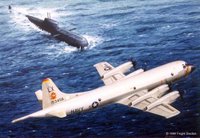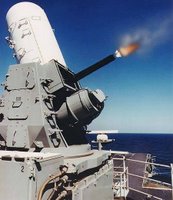 Most of the media attention has undoubtedly been focused on the F-16s, and the Indian government’s strident opposition to their sale has got more to do with bringing Indian influence on Pakistan’s move to acquire any arms than with any tactical disadvantage the Indian Air Force (IAF) might face due to these aircraft. The effectiveness of this move is evident from the fact that Belgium recently refused to sell its old F-16s to Pakistan, stating that such a sale would jeopardise the ongoing peace process with India. Even though the Bush Administration has now agreed to sell these aircraft to Pakistan, the final sale of the aircraft depends on the approval of the Congress, a procedure likely to take at least two years. Thus, for the time being, it looks as if Pakistan is not getting a single F-16. Even if the Pakistan Air Force (PAF) receives some F-16s, the aircraft, though potent, will be no match for the IAF’s MiG-29 and Su-30MKI fighters. As of now, the PAF does not have any Beyond Visual Range (BVR) missiles equipping the F-16s, which are the old block A and B type, while the IAF’s MiG-21s, MiG-29s, Mirage-2000s, and Su-30MKIs are bristling with them.
Most of the media attention has undoubtedly been focused on the F-16s, and the Indian government’s strident opposition to their sale has got more to do with bringing Indian influence on Pakistan’s move to acquire any arms than with any tactical disadvantage the Indian Air Force (IAF) might face due to these aircraft. The effectiveness of this move is evident from the fact that Belgium recently refused to sell its old F-16s to Pakistan, stating that such a sale would jeopardise the ongoing peace process with India. Even though the Bush Administration has now agreed to sell these aircraft to Pakistan, the final sale of the aircraft depends on the approval of the Congress, a procedure likely to take at least two years. Thus, for the time being, it looks as if Pakistan is not getting a single F-16. Even if the Pakistan Air Force (PAF) receives some F-16s, the aircraft, though potent, will be no match for the IAF’s MiG-29 and Su-30MKI fighters. As of now, the PAF does not have any Beyond Visual Range (BVR) missiles equipping the F-16s, which are the old block A and B type, while the IAF’s MiG-21s, MiG-29s, Mirage-2000s, and Su-30MKIs are bristling with them.
 Next in line is the Lockheed P-3C “Orion”. While the Orion is an excellent anti-submarine and anti-ship platform, it will be useless unless provided with air cover by the PAF. The PAF is not very big, nor on the cutting edge of technology, and will most likely have its hands too full combating the IAF to provide air cover to the Orions. Moreover, Pakistani naval aviation does not have dedicated fighter/interceptor aircraft in its inventory, as opposed to the Indian naval aviation, which has land-based Jaguars and Su-30MKIs along with carrier-based aircraft like Sea Harriers from the INS Viraat and shortly arriving MiG-29Ks from the Gorshkov (INS Vikramaditya), all of which have BVR capability (The Harriers are being upgraded to carry BVR missiles). These aircraft, coupled with airborne early warning aircraft like the Ka-31 helicopters (9 are already in service) and the Israeli Phalcon (3 have been ordered for the IAF), make the Indian naval aviation a potent force, rendering the lumbering Orions little more than sitting ducks. How the Indian Navy would cope with coordinated saturation attacks from many directions (for example by dozens of Mirage fighters armed with medium range Exocet anti-ship missiles, three to four Orions armed with long range Harpoon anti-ship missiles and anything else that could be thrown in to the arena) would be a matter of clever tactics and a battle of wits.
Next in line is the Lockheed P-3C “Orion”. While the Orion is an excellent anti-submarine and anti-ship platform, it will be useless unless provided with air cover by the PAF. The PAF is not very big, nor on the cutting edge of technology, and will most likely have its hands too full combating the IAF to provide air cover to the Orions. Moreover, Pakistani naval aviation does not have dedicated fighter/interceptor aircraft in its inventory, as opposed to the Indian naval aviation, which has land-based Jaguars and Su-30MKIs along with carrier-based aircraft like Sea Harriers from the INS Viraat and shortly arriving MiG-29Ks from the Gorshkov (INS Vikramaditya), all of which have BVR capability (The Harriers are being upgraded to carry BVR missiles). These aircraft, coupled with airborne early warning aircraft like the Ka-31 helicopters (9 are already in service) and the Israeli Phalcon (3 have been ordered for the IAF), make the Indian naval aviation a potent force, rendering the lumbering Orions little more than sitting ducks. How the Indian Navy would cope with coordinated saturation attacks from many directions (for example by dozens of Mirage fighters armed with medium range Exocet anti-ship missiles, three to four Orions armed with long range Harpoon anti-ship missiles and anything else that could be thrown in to the arena) would be a matter of clever tactics and a battle of wits.
 The third system is the M-220 Tube Launched, Optically Tracked, Wire Guided (TOW) Missile. It is primarily used in antitank warfare, and is a line of sight, wire-guided weapon. Current versions are capable of penetrating more than 30 inches of armour, or “any 1990s tank”, at a maximum range of more than 3,000 meters. Infantrymen using a tripod, as well from vehicles and helicopters, can fire it. It’s combat record, starting from Vietnam and continuing beyond the Gulf Wars shows it to be an overwhelming success. It was hardly influenced by the advanced counter-measures the Iraqi Army tried deploying against it. 2000 of these missiles in the hands of Pakistani soldiers will pose a grave threat to Indian armoured columns deployed in the deserts of Rajasthan and Gujarat and the plains of Punjab. Though India possesses an equally successful system, the European “Milan”, Pakistan’s acquisition of the TOW is a genuine cause of worry for the Indian Army. With hardly any Indian opposition to its sale, the deal looks likely to fall through, and many Indian tanks might fall prey to Pakistani TOWs in the event of a war.
The third system is the M-220 Tube Launched, Optically Tracked, Wire Guided (TOW) Missile. It is primarily used in antitank warfare, and is a line of sight, wire-guided weapon. Current versions are capable of penetrating more than 30 inches of armour, or “any 1990s tank”, at a maximum range of more than 3,000 meters. Infantrymen using a tripod, as well from vehicles and helicopters, can fire it. It’s combat record, starting from Vietnam and continuing beyond the Gulf Wars shows it to be an overwhelming success. It was hardly influenced by the advanced counter-measures the Iraqi Army tried deploying against it. 2000 of these missiles in the hands of Pakistani soldiers will pose a grave threat to Indian armoured columns deployed in the deserts of Rajasthan and Gujarat and the plains of Punjab. Though India possesses an equally successful system, the European “Milan”, Pakistan’s acquisition of the TOW is a genuine cause of worry for the Indian Army. With hardly any Indian opposition to its sale, the deal looks likely to fall through, and many Indian tanks might fall prey to Pakistani TOWs in the event of a war.
 The last item on the list is the Mk-15 “Phalanx” Close-In Weapon System (CIWS). This a fast-reaction, rapid-fire gun system that provides Navy ships with a terminal defence against anti-ship missiles that have penetrated other fleet defences. The radar guided 7-barrell-gun fires 20mm ammunition at either 3,000 or 4,500 rounds-per-minute with a burst length of continuous, 60, or 100 rounds. However, the Phalanx alone is not enough to defend a ship against a barrage of anti-ship missiles. Only those few missiles, which have penetrated outer fleet defences like carrier-based aircraft and short to medium range missiles, can be stopped by the Phalanx. Since Pakistan possesses no carrier-based aircraft, which is the outermost (and probably the most important) ring of such defences, their Navy ships will face a constant threat from Indian anti-ship missiles. Moreover, the ability of the Phalanx to handle missiles like the BrahMos, which fly at high supersonic speeds of more than Mach-3, is suspect.
The last item on the list is the Mk-15 “Phalanx” Close-In Weapon System (CIWS). This a fast-reaction, rapid-fire gun system that provides Navy ships with a terminal defence against anti-ship missiles that have penetrated other fleet defences. The radar guided 7-barrell-gun fires 20mm ammunition at either 3,000 or 4,500 rounds-per-minute with a burst length of continuous, 60, or 100 rounds. However, the Phalanx alone is not enough to defend a ship against a barrage of anti-ship missiles. Only those few missiles, which have penetrated outer fleet defences like carrier-based aircraft and short to medium range missiles, can be stopped by the Phalanx. Since Pakistan possesses no carrier-based aircraft, which is the outermost (and probably the most important) ring of such defences, their Navy ships will face a constant threat from Indian anti-ship missiles. Moreover, the ability of the Phalanx to handle missiles like the BrahMos, which fly at high supersonic speeds of more than Mach-3, is suspect.
Thus, though America’s recent sale of advanced weapon systems to Pakistan is a cause of worry for India, the situation is not as bad as it has been made out to be. The ability of these weapons to help Pakistani forces gain decisive tactical advantage in a battlefield is hindered by the superior technology and numbers of Indian weapons as well as the rigorous training the Indian armed forces receive. However, wars have a habit of throwing up some very unpleasant surprises and ultimately it will be our ability to cope with them that will decide the outcome of any future conflict.

1 comment:
say bye bye too ur su 30 mki squardons....we will avenge pns mehran and the orions.
Post a Comment